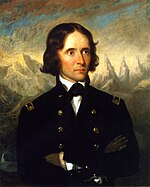Presidency of John Tyler
After the election, however, as a strict constructionist, Tyler found some of the program then introduced by the Whigs in Congress unconstitutional and thus vetoed several bills favored by party leader Henry Clay.
Because of his injection of that issue, pro-annexation Democrats blocked the renomination of former President Van Buren, who opposed annexation and nominated instead the previously little known James K. Polk, who went on to defeat Clay, the Whig candidate, in the general election.
[3][4] After his inauguration, Harrison called for a special session of Congress, to begin in late May, in order to address the dangerous financial condition of a country still in the midst of the Panic of 1837.
[12] Tyler delivered an inaugural address before Congress on April 9, in which he reasserted his belief in fundamental tenets of Jeffersonian democracy and limited federal power.
[19] Fearing that he would alienate Harrison's supporters, Tyler decided to keep the dead president's entire cabinet even though several members were openly hostile to him and resented his assumption of the office.
Adhering to his states' rights, strict-constructionist ideology and having joined the Whigs only in opposition to Andrew Jackson, he did not embrace the American System of internal improvements, protective tariffs, and national bank proposals of the party leaders.
Following Tyler's veto of two Whig banking bills, in September 1841 all the members of the cabinet except Webster resigned in protest, a maneuver that Clay had engineered.
Clay's advocacy was motivated in part by the poor economic conditions inherited from the Van Buren administration; he and his allies argued that the re-establishment of a national bank would help lift the economy.
Believing it improper to continue distribution at a time when federal revenue shortage necessitated increasing the tariff, Tyler vetoed both bills, burning any remaining bridges between himself and the Whigs.
[59][60] Despite the rejection of the Botts resolution, a House select committee, headed by John Quincy Adams, condemned the president's use of the veto and assailed his character.
He was a disciple of Madison and Jefferson in his belief that territorial and commercial expansion would allay sectional differences, preserve the Union, and create a nation of power and glory unparalleled in history.With his domestic agenda frustrated in Congress, Tyler worked with Secretary of State Webster to pursue an ambitious foreign policy.
[72] As part of this conciliatory policy, the Tyler administration launched a secret propaganda campaign to influence public opinion in favor of an Anglo-American treaty that would settle the border between Maine and Canada.
[71] British diplomat Lord Ashburton arrived in Washington in April 1842, and after months of negotiations the United States and Britain agreed to the Webster–Ashburton Treaty in August 1842.
[77] The treaty represented an important point in the growing warmth of Anglo-American relations after the War of 1812, as it showed that both countries accepted joint control of North America.
[95] Tyler brought the long, bloody Second Seminole War in Florida to an end in 1842, and expressed interest in the forced cultural assimilation of the Native Americans.
[105] Looping back to the east to stay on the eastern side of the Sierra Nevada mountain range, they turned south again reaching the Carson River on January 18, 1844.
After taking office as president of Mexico in 1833, Antonio López de Santa Anna centralized policies and triggered revolts, including the Texas Revolution.
The Mexican Congress refused to ratify the treaty, which had been obtained from Santa Anna under duress, and Mexico continued to regard Texas as a breakaway province.
[112] With the help of newly appointed Treasury Secretary John C. Spencer, Tyler cleared out an array of officeholders, replacing them with pro-annexation partisans, in a reversal of his former stand against patronage.
In exchange for an appointment as consul to Hawaii, journalist Alexander G. Abell wrote a flattering biography, Life of John Tyler, which was printed in large quantities and given to postmasters to distribute.
Upshur and his adviser, Duff Green, believed that Britain sought to convince Texas to abolish slavery in a complicated scheme designed to undermine the interests of the Southern United States.
[120] A ceremonial cruise down the Potomac River was held aboard the newly built USS Princeton on February 28, 1844, the day after completion of the annexation treaty.
[121] A malfunction caused an explosion that killed Gilmer and Upshur, as well Virgil Maxcy, David Gardiner, Commodore Beverly Kennon, and Armistead, Tyler's black slave and body servant.
Former Vice President Richard Mentor Johnson of Kentucky, former Secretary of War Lewis Cass of Michigan, and Senator James Buchanan of Pennsylvania also loomed as contenders for the 1844 Democratic presidential nomination.
[143] The candidate of the abolitionist Liberty Party, James G. Birney, won several thousand anti-annexation votes in New York, and his presence in the race may have cost Clay the election.
[147] In late February 1845, the House by a substantial margin and the Senate by a bare 27–25 majority approved a joint resolution offering terms of annexation to Texas.
[147] On March 3, the final full day of his presidency, Tyler extended an offer of annexation and statehood to Texas through his envoy, Andrew Jackson Donelson.
Monroe credits him with "achievements like the Webster–Ashburton treaty which heralded the prospect of improved relations with Great Britain, and the annexation of Texas, which added millions of acres to the national domain."
Crapol argued that Tyler "was a stronger and more effective president than generally remembered", while Seager wrote, "I find him to be a courageous, principled man, a fair and honest fighter for his beliefs.
[161] Louis Kleber, in his article in History Today, pointed out that Tyler brought integrity to the White House at a time when many in politics lacked it, and refused to compromise his principles to avoid the anger of his opponents.







